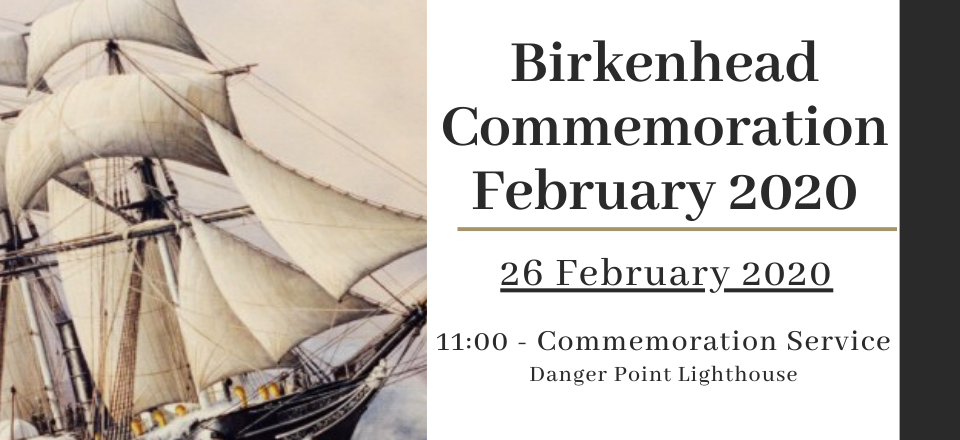HMS Birkenhead Ceremony - 26 February 2020
Today was a beautiful day with a clear blue sky. This afternoon we began to hear the foghorn from Danger Point Lighthouse just 10 minutes from our home, as the fog rolled in from the South Atlantic. A mournful sound that brings to mind the many ships and boats that have foundered on this treacherous piece of coastline with Danger Point sticking out into the sea and the reefs offshore merely feet below the surface.
Thus it was on the morning (about 02:00 hrs) of the 26th February 1852 that HMS Birkenhead struck the reef. There being insufficient lifeboats the tradition of 'Women and Children' first was started and the soldiers on the ship stood back and faced their fate in the treacherous waters on this rugged coastline.
THIS EVENT IS COMMEMORATED EVERY 26TH FEBRUARY AND ALL ARE WELCOME TO GATHER AT THE BIRKENHEAD LIGHTHOUSE FOR THE CEREMONY on 26 February 2020.
Here are the regiments that were present and the story of HMS Birkenhead.
HMS Birkenhead military units:
2nd Foot (The Queen's Royal West Surrey Regiment)
• 1 Ensign
• 1 Sergeant
• 50 Men
6th Foot (Royal Warwickshire Regiment)
• 1 Ensign
• 1 Sergeant
• 60 Men
12th Lancers (9th/12th Royal Lancers)
• 2 Cornets
• 1 Sergeant
• 5 Men
12th Foot (Suffolk Regiment)
• 1 Sergeant
• 68 Men
43rd Light Infantry (1st Battalion Oxford and 1 Lieutenant Buckinghamshire Light Infantry)
• 1 Sergeant
• 40 Men
45th Foot (1st Battalion Nottinghamshire and 1 Warrant Officer Derby Regiment)
• 1 Sergeant
• 15 Men
73rd Foot (2nd Battalion Royal Highland Regiment)
• Lieutenant
• 1 Ensign
• 1 Sergeant
• 70 Men
74th Foot (2nd Battalion Highland Light Infantry)
• 1 Lieutenant Colonel
• 1 Ensign
• 1 Warrant Officer
• 60 Men
91st Foot (1st Battalion Argyll & Sutherland 1 Captain Highlanders)
• 2 Sergeants
• 100 Men
Others on board were made up of
• 31 Children
• 25 Women
• 1 Naval Surgeon
• 17 Ship's Officers
• 125 Crew
• 3 Military Surgeons"
"In January 1852, under the command of Captain Robert Salmond, the HMS Birkenhead left Portsmouth conveying troops to the 8th Xhosa War in South Africa. On 5 January she picked up more soldiers at Queenstown and was also conveying some officers' wives and families. On 23 February 1852, the Birkenhead docked at Simonstown, near Cape Town. Most of the women and children disembarked along with a number of sick soldiers. Nine cavalry horses and several bales of hay were loaded for the last leg of the voyage to Algoa Bay.
In the late afternoon of 25 February 1852, the Birkenhead left Simon's Bay with approximately 643 men, women, and children aboard, under instructions to reach its destination at Algoa Bay as quickly as possible. In order to make the best possible speed, Captain Salmond decided to hug the South African coast, setting a course which was generally within 3 miles (4.8 km) of the shore. She maintained a steady speed of 8.5 knots (15.7 km/h). The sea was calm and the night was clear as she left False Bay and headed east.
At 2 a.m. the following morning, the Birkenhead struck an uncharted rock near Danger Point (today near Gansbaai). The barely submerged rock is clearly visible in rough seas, however it is not immediately apparent in calmer conditions. The initial impact ripped open the forward watertight compartment between the engine room and the fore peak, immediately flooding it and drowning over 100 soldiers in their hammocks. A second impact ripped open the bilge in the engine room, resulting in the two largest watertight compartments in the vessel being flooded.
The surviving officers and men assembled on deck. Distress rockets were fired, but there was no assistance available. Sixty men were detailed to man the chain pumps, sixty more were assigned to the tackles of the lifeboats, while the rest were assembled on the poop deck, in order to raise the forward part of the ship. Poor maintenance and paint on the winches resulted in only a few of the ship's lifeboats being launched, and the two large boats, with capacities of 150 men each, were not among them. Eventually two cutters and a gig were launched, onto which all the women and children were placed and rowed away for safety. Only then did Captain Salmond order that those men who could swim should save themselves by swimming to the boats; Lieutenant-Colonel Seton, however, recognising that rushing the lifeboats would risk swamping them and endangering the women and children, ordered the men to stand fast. The cavalry horses were freed and driven into the sea in the hope that they might be able to swim ashore. The soldiers did not move, even as the ship broke up barely twenty minutes after striking the rock. Some of the soldiers managed to swim the 2 miles (3.2 km) to shore over the next twelve hours, often hanging on to pieces of the wreck to stay afloat; however, most either drowned or were taken by sharks.
Danger Point Lighthouse - The next morning the schooner Lioness discovered one of the cutters, and after saving the occupants of the second boat made her way to the scene of the disaster. Arriving in the afternoon, she rescued as many people as possible. It was reported that of the 643 people aboard the Birkenhead, only 193 were saved. The actual number of personnel aboard is in some doubt, but an estimate of 638 was published in the Times newspaper. It is generally thought that the survivors comprised 113 Army personnel (all ranks), 6 Royal Marines, 54 seamen (all ranks), 7 women 13 children and at least 1 male civilian, but these numbers cannot be substantiated as muster rolls and books were lost with the ship. Of the horses onboard, eight made it safely to land, while the ninth had its leg broken while being pushed into the sea.
This disaster started the protocol of "women and children first!", which became a standard evacuation procedure in maritime disasters. Similarly, "Birkenhead Drill" carried out by the soldiers became the epitome of courageous behaviour in hopeless circumstances.
In 1895, a lighthouse was erected at Danger Point to warn shipping of the dangerous reef. The lighthouse is about 18 metres (59 ft) tall and is visible for approximately 25 nautical miles (46 km). A remembrance plate for the Birkenhead is affixed to its base, and points to the rock where the ship was wrecked."













































